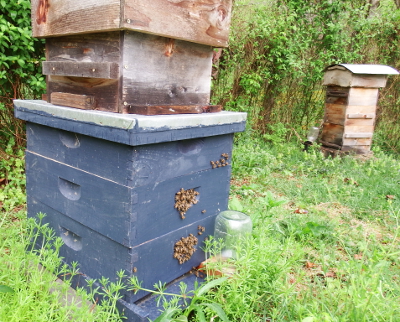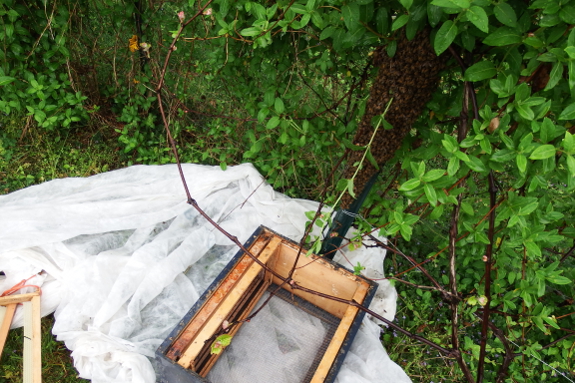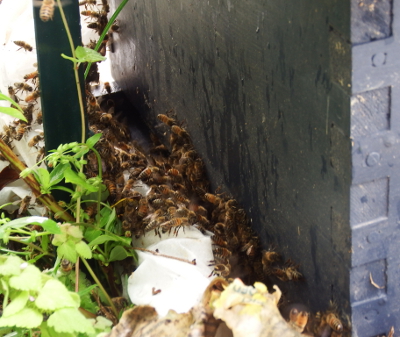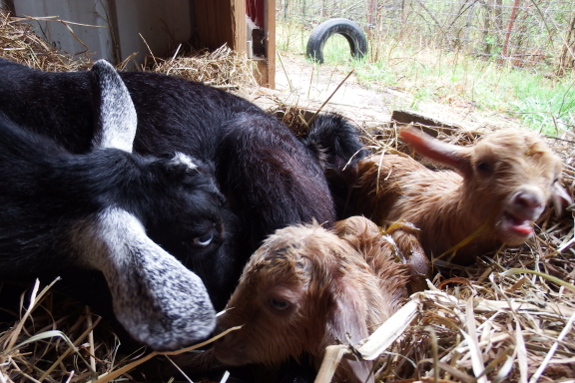
(Almost) catching a swarm
 I'll bet you thought today's post was going to be about goats, didn't you? After checking on Artemesia Friday morning
and finding the kidding signs ominous but not necessarily imminent, I
decided to fill my day with small chores that could be easily
interrupted by trips to the goat barn. "Maybe I'll start by pruning that
grape vine I've been putting off since March," I said to myself.
I'll bet you thought today's post was going to be about goats, didn't you? After checking on Artemesia Friday morning
and finding the kidding signs ominous but not necessarily imminent, I
decided to fill my day with small chores that could be easily
interrupted by trips to the goat barn. "Maybe I'll start by pruning that
grape vine I've been putting off since March," I said to myself.
Heading over to the vine with clippers in hand, I was surprised to notice bees hanging out on the outside of one of our hives.
If it had been a hot afternoon, that could have been cooling behavior.
But the morning was chilly and drizzly. Uh oh --- looked like in all of
my goat obsession recently, I'd allowed the hive to swarm.
But this time, the swarm
was neither gone nor on a branch fifty feet above my head. Instead,
they'd settled on the U-post onto which Mark had attached a trellis wire
to train the young grape --- yes, the precise plant I'd come out to
prune.

Mark was in town filming a
student project, so I called my beekeeping mentor instead. Frankie's
primary role in this project was calming me down --- I was pretty
jittery between my pre-dawn goat-barn visit and thinking through trying
to catch a swarm on my lonesome. But my mentor also gave me good advice
--- don't forget to put a sheet underneath the new hive (I used row
cover fabric) and shake the post rather than trying to brush the bees
into the hive.
 Thump, thump! The
mass of bees fell (mostly) into the deep Langstroth box exactly as
planned. But when I looked more closely, I realized the ones outside
weren't crawling in the way they should have if the queen was inside the
box. And when I braved the honeysuckle to look at the indented side of
the U-post, I saw that a considerable amount of the cluster was still
hidden in that cavity.
Thump, thump! The
mass of bees fell (mostly) into the deep Langstroth box exactly as
planned. But when I looked more closely, I realized the ones outside
weren't crawling in the way they should have if the queen was inside the
box. And when I braved the honeysuckle to look at the indented side of
the U-post, I saw that a considerable amount of the cluster was still
hidden in that cavity.
So I thumped again,
gnawed on my fingernails, called my beekeeping mentor...and was ecstatic
when a trip to the hive half an hour later found the box humming with
life and nearly every bee inside. (Yes, I'd inserted the frames and put
on the lid earlier.) Success!
Or so I thought. After
watching Artemesia deliver two healthy kids (more on that in tomorrow's
post) and spending a few hours cleaning the twins up and making sure
they could nurse, I went back to check on the bees. The box was empty,
my swarm fled. Yet again, I'd lost our hive's propagule to the wilds.

What would I do
differently next time? First, I would have listened to my beekeeping
mentor and my gut and checked out that hive earlier in the week. But all
I could think about was goats and gardens, so the bees once again ended
up on the back burner.
Second, once I saw that
the new hive contained most of my swarm, I think I might have blocked
off the entrance for a day. Surely that would have helped them decide
the box was home.
Third, if it hadn't been
raining, it might have helpted to take a comb of brood out of the mother
hive and insert it into the swarm box. After all, they say bees won't
leave brood.
All of that said, two bouncing goatlings are quite a consolation prize. And one of these days, I'll catch...and keep...a swarm.
Want more in-depth information? Browse through our books.
Or explore more posts by date or by subject.
About us: Anna Hess and Mark Hamilton spent over a decade living self-sufficiently in the mountains of Virginia before moving north to start over from scratch in the foothills of Ohio. They've experimented with permaculture, no-till gardening, trailersteading, home-based microbusinesses and much more, writing about their adventures in both blogs and books.
Want to be notified when new comments are posted on this page? Click on the RSS button after you add a comment to subscribe to the comment feed, or simply check the box beside "email replies to me" while writing your comment.

Two things. You know, if you ask two beekeepers you get three answers, but here are two quick thoughts from me.
1) From the photo, it looks like your hive entrances are pretty low to the ground. Consider raising your hives, even onto a cinder block is helpful. I find that very low hives without very clear "flight paths" or with less-than ideal sun exposure just a little bit more likely to make their "community decision" to swarm. Its a small thing, but think about it.
2) Since you guys have extra equipment, I'd strongly recommend putting out a "bait hive" in the spring. It doesn't always work, but when it does it feels almost miraculous. A little lemongrass oil seems to do the trick. These guys have some really really great suggestions about making bait hives and (very importantly) siting them in places that are very desirable for the scout bees.
I hope you're having a wonderful day with new babies on the land! xoxo -C
http://www.horizontalhive.com/honeybee-swarm-trap/bait-hive-how-to-catch.shtml
CW --- Thanks for the tips! We actually have the hives up on one set of cinderblocks (the weeds are getting high, so it's hard to tell in the photos). Do you think we should go higher than that?
On bait hives --- we followed all of the instructions and set those out with lemongrass oil for two springs. Nothing. So I finally gave up. I do keep the old equipment in the barn in a bee-accessible manner, though, and we once had a swarm move in. That was magical!